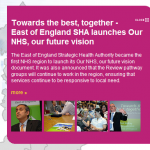There was a sudden chill in the air when I uttered those words in a client meeting this week.
We’re planning another high-profile WordPress-based website, with ‘mashing’ of RSS feeds from third-party sites like YouTube and Flickr a prominent ingredient. In practice, that means the site’s photo galleries and video streaming have been ‘contracted out’ to the companies recognising as the best in the world. And courtesy of their RSS feeds, we’ll be able to display the latest additions on the site, more or less seamlessly. The main site will be updated automatically, as soon as you upload your image or clip, give or take a slight delay for feed cacheing. And the media items will be available to members of those sites’ communities worldwide, making it easier to find and (theoretically) share.
My mind inevitably drifted back to the Bad Old Days, and the weeks I spent discussing, writing and reviewing Functional Specifications. I can imagine how long it would have taken, a couple of years back, to get anything like the functionality which Flickr and YouTube offer me, free of charge, in a matter of moments. And for all the risks of using a third-party service, with no formal SLA per se, I’ve yet to see things go any more wrong than any equivalent function you might have commissioned from one of the Big Ugly Consultancies. (If at all.)
 Case in point: It took a couple of hours last week – from a standing start – to decide to use Flickr for photos from the regional launches of NHS future visions, as chronicled by the Our NHS Our Future website, and work out how we might do it. The images are now featuring (automatically, courtesy of Flickr’s tag feeds) in the popups on the homepage map. It makes the whole thing much more personal and human… which is entirely in keeping with the exercise itself. And it’s basically Flickr plus an RSS parser doing all the work.
Case in point: It took a couple of hours last week – from a standing start – to decide to use Flickr for photos from the regional launches of NHS future visions, as chronicled by the Our NHS Our Future website, and work out how we might do it. The images are now featuring (automatically, courtesy of Flickr’s tag feeds) in the popups on the homepage map. It makes the whole thing much more personal and human… which is entirely in keeping with the exercise itself. And it’s basically Flickr plus an RSS parser doing all the work.
Fact is, it’s now outrageously easy to integrate best-of-breed video and photo functionality in any website. The technology is straightforward, and the (lack of a) pricetag means the bulk of the bureaucracy can be avoided. It used to be a case of ‘how would we do it?’. Now it’s more like ‘why aren’t we doing it?’.